Key Takeaways
- Just 14 states and D.C. have passed paid family leave policies.
- The average paid maternity leave maximum payment is $1,140.66 a week among states that offer it.
- Just 12% of the lowest 25th percentile wage earners receive paid family benefits, while 37% of workers in the highest 25th percentile receive benefits.
- As of March 2022, 43% of private sector employees had access to short-term disability insurance (STDI) coverage, which provides employer-sponsored full or partial paid leave.
Paid leave for parents welcoming a new baby to their family is a hot topic, as the cost of living puts pressure on single-income households and child care costs exceed $10,000 a year.
Family leave is designed to support parents as their families and finances change, but the U.S. doesn’t offer federal paid parental leave protections. This means many expecting parents don’t have guaranteed access to paid parental leave.
Below we dig into the average paid maternity leave by state and other family leave statistics potential parents and growing families need to know.
Best States for Working Parents
We compared state laws, weekly maximum wages, paid weeks off and other important metrics to determine which states of the 13 that offer paid family leave have the best coverage.
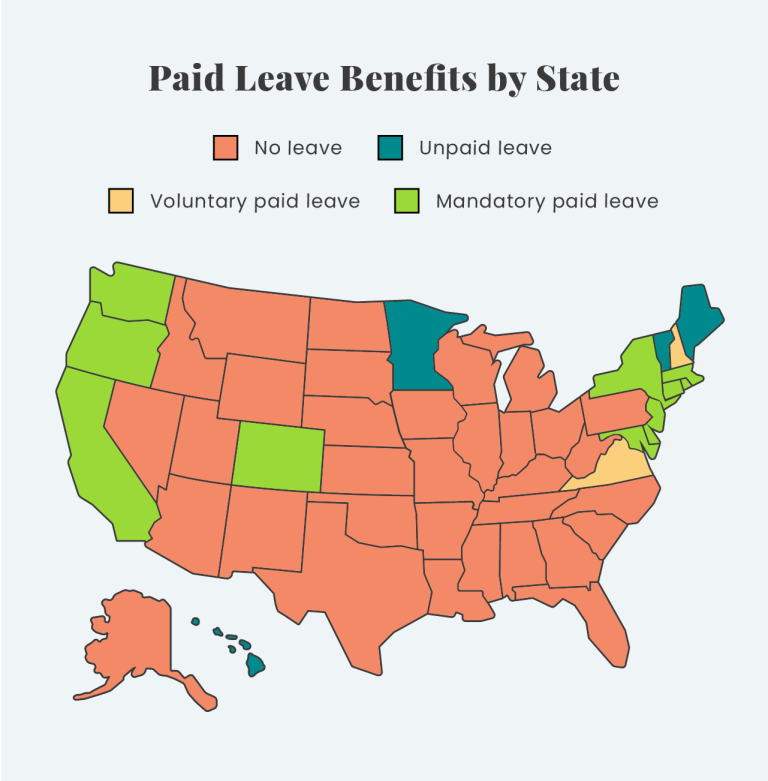
Our study found that Oregon has the best paid family leave, while Virginia’s voluntary paid leave program has some of the weakest benefits for parents.
Below is a list of states with paid or unpaid leave programs ordered from best to worst.
| State | State Family Leave Law | Leave Period (weeks) | Max Weekly Benefit |
|---|---|---|---|
| Oregon | Mandatory, Active | 12 | $1,568.60 |
| Washington | Mandatory, Active | 12 | $1,542 |
| New York | Mandatory, Active | 12 | $1,177.32 |
| New Hampshire | Voluntary, Active | 6 or 12 (determined by insurer) | $2,031.92 |
| California | Mandatory, Active | 8 | $1,681 |
| Colorado | Mandatory, Active | 12 | $1,324.21 |
| District of Columbia | Mandatory, Active | 12 | $1,153 |
| Delaware | Mandatory, Inactive | 12 | $900 |
| Massachusetts | Mandatory, Active | 12 | $1,170.64 |
| Rhode Island | Mandatory, Active | 6 | $1,070 |
| Maryland | Mandatory, Inactive | 12 | $1,000 |
| New Jersey | Mandatory, Active | 12 | $1,055 |
| Connecticut | Mandatory, Active | 12 | $981 |
| Minnesota | Unpaid | 12 | N/A |
| Vermont | Unpaid | 12 | N/A |
| Maine | Unpaid | 10 | N/A |
| Virginia | Voluntary, Active | Determined by insurer | N/A |
| Wisconsin | Unpaid | 6 | N/A |
| Hawaii | Unpaid | 4 | N/A |
#1: Oregon
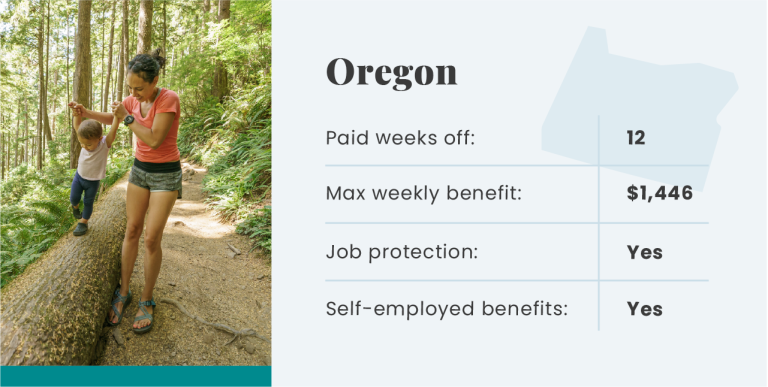
Oregon’s mandatory paid family leave law officially went into effect in January 2023, so it’s one of the newest laws implemented in the U.S.
Oregon offers 12 weeks of paid leave, earning 100% of an individual’s average weekly wage (AWW) up to 65% of the state’s average weekly wage (SAWW) of $1,307.17. After that, individuals earn 50% of their AWW for income over 65% the SAWW ($849.66) up to a maximum $1,568 weekly benefit.
#2: Washington
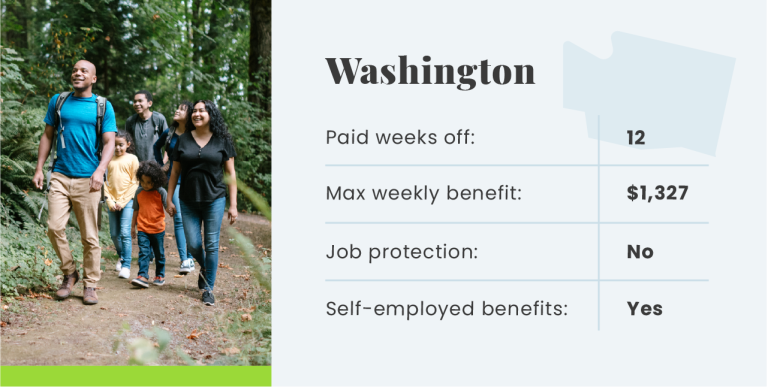
Washington workers receive similar benefits, including mandatory employer participation and up to 12 weeks of paid time off. Income benefits are slightly increased, with a maximum weekly benefit of $1,542,
Washington state law also excludes job protections, though most workers are eligible for federal protections and unpaid time off through the Family and Medical Leave Act (FMLA).
#3: New York
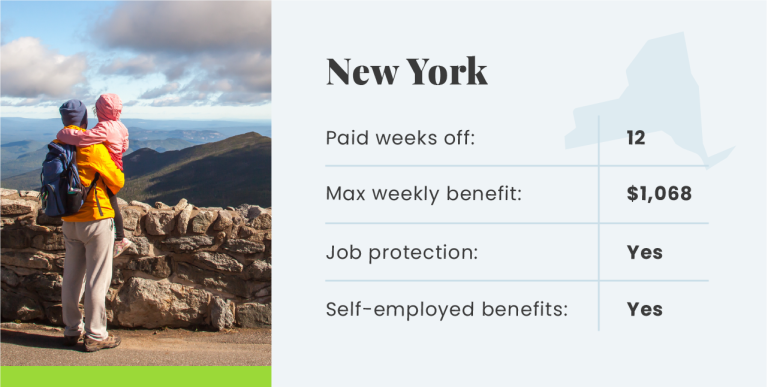
New York employers are also required to provide paid family leave up to 12 weeks a year for eligible employees. Workers may receive 67% of their average weekly wage up to the maximum benefit of $1,177.32 a week.
Worst States for Paid Family Leave
Paid family leave isn’t offered by a majority of U.S. states, though some do have laws protecting unpaid leave or providing paid benefits to state employees. The lack of protections almost made our worst states list a 34-way tie, though wages play a key factor in paid leave access.
| State | Median Weekly Salary |
|---|---|
| Mississippi | $909.33 |
| Arkansas | $936.85 |
| Louisiana | $952.89 |
| New Mexico | $953.62 |
| Oklahoma | $985.78 |
| Kentucky | $996.19 |
| Alabama | $999.25 |
| South Carolina | $1,003.28 |
| Tennessee | $1,019.38 |
| West Virginia | $1,020.45 |
| Missouri | $1,026.26 |
| North Carolina | $1,028.94 |
| Nebraska | $1,032.87 |
| Iowa | $1,037.91 |
| Indiana | $1,049.98 |
| South Dakota | $1,050.67 |
| Ohio | $1,051.75 |
| Idaho | $1,052.99 |
| Kansas | $1,055.43 |
| Texas | $1,062.56 |
| Georgia | $1,065.60 |
| Florida | $1,067.16 |
| Michigan | $1,079.84 |
| Nevada | $1,091.46 |
| Montana | $1,101.02 |
| North Dakota | $1,117.70 |
| Arizona | $1,120.46 |
| Wisconsin | $1,110.34 |
| Maine | $1,110.74 |
| Wyoming | $1,159.71 |
| Pennsylvania | $1,162.20 |
| Illinois | $1,177.84 |
| Vermont | $1,125.55 |
| Alaska | $1,284.28 |
| Minnesota | $1,255.61 |
| Utah | $1,349.73 |
| Hawaii | $1,452.69 |
Just 12% of the lowest-paid workers in the U.S. have access to employer-provided paid leave, while 21% of these same workers can access paid short-term disability insurance (STDI).
On the opposite end of salary ranges, 40% of the highest earners receive paid leave and 65% can access STDI benefits.
A majority of workers also have access to unpaid leave, though low-income workers are far less likely to take advantage of these benefits due to financial and career concerns.
For these reasons, median income as well as state employee benefits and unpaid leave laws were considered to determine the states with the worst paid leave laws.
#51: Mississippi
Mississippi offers no paid family leave protections for workers and also has the lowest median income in the U.S. This leaves families responsible for budgeting for unpaid time off or finding and funding child care so that new parents can return to work.
The low pay also makes it difficult for families to take advantage of unpaid leave protections via FMLA.
Demographics play an important role in parental leave access, as Mississippi has the highest population of Black Americans in the U.S. at 38%. Research shows that people of color have the least access to paid family leave, and 4 in 10 Black women in particular don’t feel like they can take advantage of the leave they need.
#50: Arkansas
Arkansas is the second lowest-paying state in the U.S. and doesn’t have any state laws protecting paid family leave. With a median income of just $936.85 a week, Arkansas workers earn less on average than the maximum weekly paid benefit of 11 out of 13 states that offer it.
#49: Louisiana
The Gulf State of Louisiana rounds out our bottom three states for paid parental leave with a median weekly pay just $16 higher than Arkansas’. There are no current Louisiana laws protecting paid or unpaid family leave benefits for workers.
75% of Americans Don’t Receive Paid Family Leave
The U.S. offers no federal paid leave protections, and the BLS estimates just 25% of workers have access to paid family leave through state and employer-provided benefits.
Access to paid parental leave is heavily associated with income and industry, and it also varies by socioeconomic demographics.
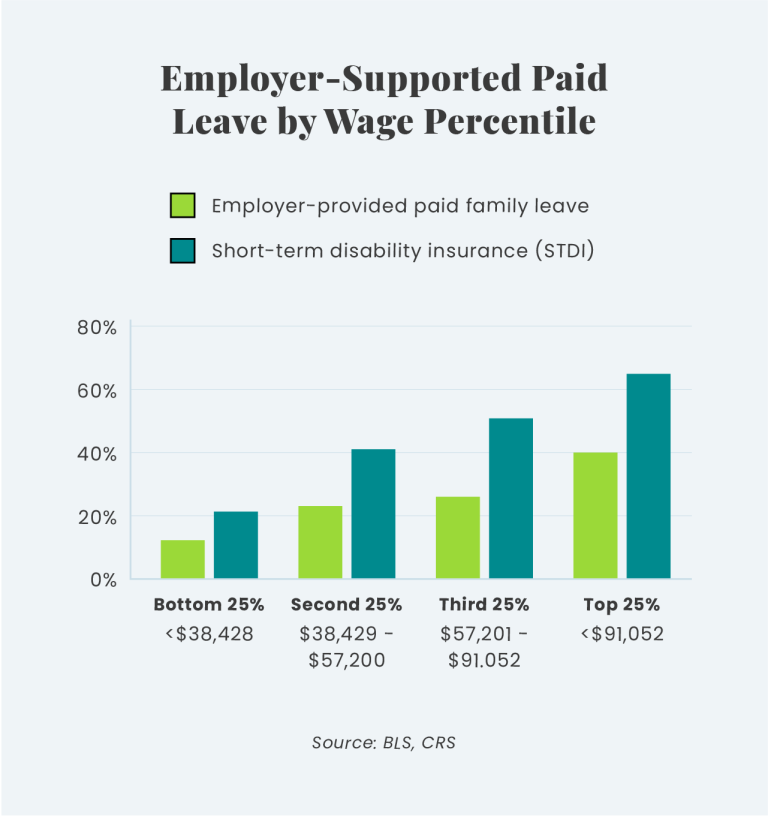
- Access to paid family leave is highest for state and government employees at 27%, compared to 24% for private industry workers.
- Paid family leave access increases with income. Just 12% of the lowest 25th percentile wage earners receive paid family benefits, while 37% of workers in the highest 25th percentile receive benefits.
- Of the 13 states and D.C. that offer paid family leave, only 12 require employers to offer paid family leave insurance. Paid family leave insurance is voluntary in Virginia and New Hampshire.
- As of March 2022, 43% of private sector employees had access to STDI, which provides employer-sponsored full or partial paid leave.
- The median STDI benefit offers a median 60% fixed percentage of lost earnings, or a median maximum weekly benefit of $993 a week, depending on the STDI plan.
- STDI plans offer a median 26 weeks of benefits coverage.
- The U.S. is the only country of 38 in the Organization for Economic Co-operation and Development (OECD) that doesn’t offer any federal paid maternity leave.
- 35 out of 38 OECD countries also offer paid paternal leave for fathers.
Navigating the intricacies of parental leave is a challenge that hits home for me. I’m currently on the precipice of welcoming my first child into the world, and my family’s story reflects the complexities many American parents face when it comes to paid leave. My employer, a small company, doesn’t offer paid leave, and our size disqualifies us from the protection of the Family and Medical Leave Act (FMLA). In situations like this, the safety net often comes in the form of state-based paid medical and family leave programs.
If you’re committed to spending as much time as possible with your little one during their earliest, most formative days, it’s essential to prepare for the potential income shortfall.
FMLA and Unpaid Parental Leave in the U.S.
The Family and Medical Leave Act was enacted in 1993 to give eligible employees unpaid time off to provide family and medical care. FMLA provides job protections and ensures continued health insurance coverage for up to 12 workweeks in a 12-month period to care for a newborn or newly adopted/fostered child.
Unpaid leave protections are available to a majority of U.S. workers, though low-income workers and Americans of color are least likely to have access or the ability to take advantage of these programs.
- Just over 90% of U.S. workers have access to unpaid family leave, with state and local government workers having the highest access rate at 94%.
- Nearly 15 million workers used FMLA benefits in 2022.
- 20.8% of FMLA leave was used to care for a newborn, adopted or foster child as of 2018.
- People of color have higher ineligibility rates than white workers:
- 55%: Native American, Pacific Islander, or multiracial workers
- 48%: Latinx workers
- 47%: Asian American workers
- 43%: Black workers
- 42%: white workers
- A majority (nearly 80%) of Black mothers are the primary breadwinners, but nearly 4 in 10 Black women don’t take unpaid leave they need.
- Black women lose an estimated $3.9 billion in income each year to unpaid or poorly paid leave.
- Single parents are the least likely to take needed FMLA coverage at 16%, followed by Native American, Pacific Islander and multiracial parents (12%).
- Despite federal protections, nearly 2.7 million workers who needed FMLA coverage in 2022 didn’t take it for fear of job loss.
- About two-thirds (7.2 million) of the 10.9 million workers who needed and refused FMLA coverage did so because they couldn’t afford unpaid leave.
Lacking Leave Protections and Gender Disparities
Paid leave has proven implications for the health and well-being of children, as well as the emotional and financial stability of mothers. Gender-based expectations for parenting and the unpaid emotional and household labor that comes with it is a key factor in the gender wage gap.
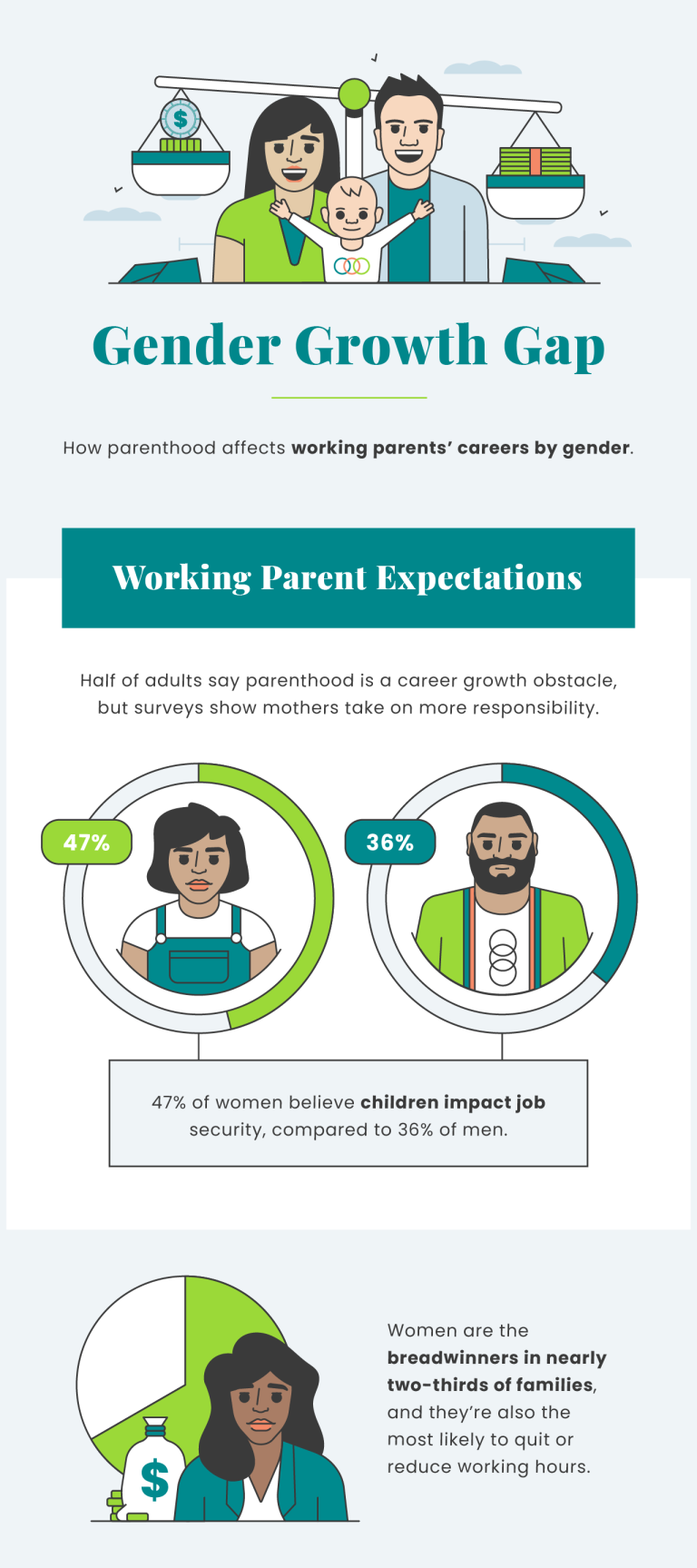
- Just 5% of working fathers took more than two weeks off after their last child’s birth, and 60% of low-income fathers took no paid time off.
- California fathers account for 43% of paid family leave requests to care for a new child — a 17% increase from the program’s release in 2004.
- Women are the primary earners in nearly two-thirds of families with children, but are the most likely to quit or reduce their working hours after birth.
- One additional month of paid paternal leave can boost a mother’s income by 7%.
- Women are 93% more likely to return to work within nine to 12 months after birth if they take paid family leave.
Getting Ready for Maternity Leave
From the first positive test, pregnancy launches a seemingly endless list of to-dos and doctors appointments. Managing the health of mother and baby, the excitement of a growing family and the financial needs of it all can feel overwhelming.
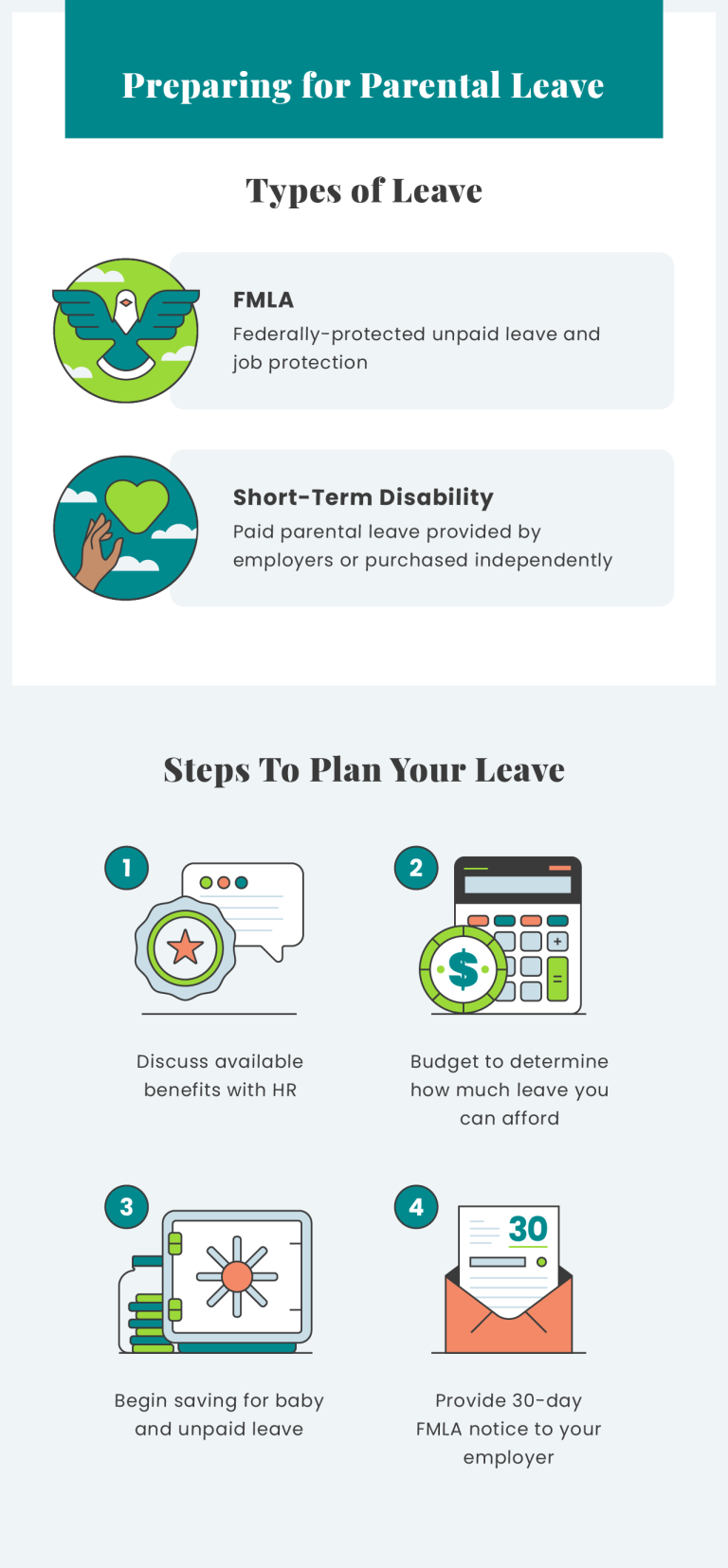
We’ve gathered these resources to help you understand your options and prepare for parental leave:
- American Pregnancy Association: types of maternity leave
- FMLA: eligibility and federal resources
- Family Leave Workshop: resources to advocate for paid family leave at your workplace
- Care: maternity leave timeline
Budgeting for parental leave and preparing for all the changes a new baby brings can be stressful — especially for first-time parents. While laws protecting maternity leave vary by state, there are still resources to help parents plan ahead and get their personal finances in order.
Editor Chase Campbell contributed to this article.




